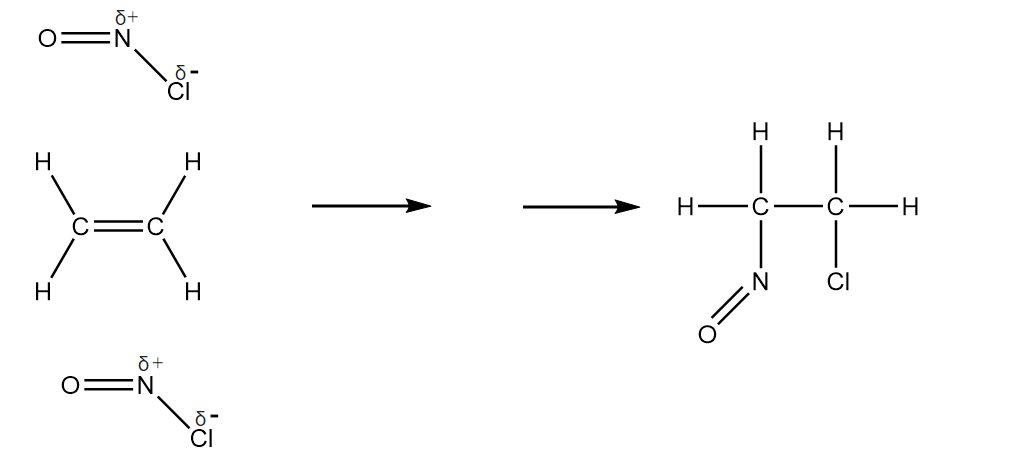
Nitrosyl chloride,
Include all necessary charges, lone pairs, curly arrows and the structure of organic intermediate.


Answer
425.1k+ views
Hint: Nitrosyl chloride is a chemical compound with molecular formula
Complete answer:
The addition of nitrosyl chloride to an ethene molecule takes place in three steps. The mechanism for the addition reaction of
Step-1: Dissociation of nitrosyl chloride into respective cation and anion. The reaction takes place as follows:
Step-2: In ethene,

Step-3: The chloride ion will act as a nucleophile and attack the carbocation formed in the previous step to give the final product. The reaction proceeds as follows:

Hence, the final diagram for the given reaction mechanism will be as follows:

Note:
It is important to note that the addition of nitrosyl chloride to ethene is a stereospecific reaction i.e., the two stereochemical products are possible after the reaction. If chloride ion attacks carbocation from the sample plane where the nitrosyl group is attached, then the product formed is syn whereas if chloride ion attacks from opposite plane, then the product formed is termed as anti.
Complete answer:
The addition of nitrosyl chloride to an ethene molecule takes place in three steps. The mechanism for the addition reaction of
Step-1: Dissociation of nitrosyl chloride into respective cation and anion. The reaction takes place as follows:
Step-2: In ethene,

Step-3: The chloride ion will act as a nucleophile and attack the carbocation formed in the previous step to give the final product. The reaction proceeds as follows:

Hence, the final diagram for the given reaction mechanism will be as follows:

Note:
It is important to note that the addition of nitrosyl chloride to ethene is a stereospecific reaction i.e., the two stereochemical products are possible after the reaction. If chloride ion attacks carbocation from the sample plane where the nitrosyl group is attached, then the product formed is syn whereas if chloride ion attacks from opposite plane, then the product formed is termed as anti.
Recently Updated Pages
Master Class 11 Economics: Engaging Questions & Answers for Success

Master Class 11 Business Studies: Engaging Questions & Answers for Success

Master Class 11 Accountancy: Engaging Questions & Answers for Success

Master Class 11 English: Engaging Questions & Answers for Success

Master Class 11 Computer Science: Engaging Questions & Answers for Success

Master Class 11 Maths: Engaging Questions & Answers for Success

Trending doubts
Which one is a true fish A Jellyfish B Starfish C Dogfish class 11 biology CBSE

State and prove Bernoullis theorem class 11 physics CBSE

1 ton equals to A 100 kg B 1000 kg C 10 kg D 10000 class 11 physics CBSE

In which part of the body the blood is purified oxygenation class 11 biology CBSE

One Metric ton is equal to kg A 10000 B 1000 C 100 class 11 physics CBSE

Difference Between Prokaryotic Cells and Eukaryotic Cells




